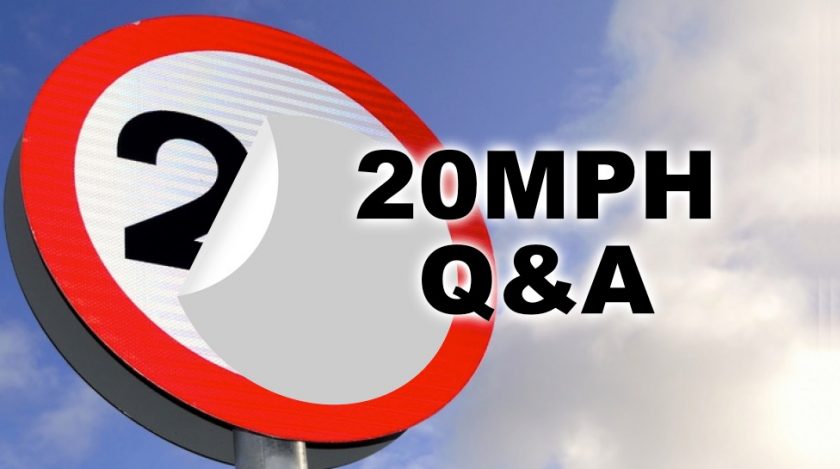Council working on logistics for overnight 20MPH Zone switch as part of £500k change coming in September

New signage, an overnight switch over, and a £500k bill is in store for Wrexham as plans for 20MPH zones are set for roll out in eleven weeks time.
With the lack of information from Welsh Government locally, and lack of information from Wrexham Council on the 20MPH move we spoke with Cllr Hugh Jones – the Executive Board Lead Councillor who is responsible for the roll out.
Described as the ‘biggest step-change in community safety in a generation’, most streets in Wales that currently have a 30mph speed limit will switch to 20mph on Sunday, September 17, although its still unknown which Wrexham streets will avoid the change.
Last week Wrexham.com spoke with Cllr Jones, lead member for environment at Wrexham Council.
Cllr Hugh Jones gave a background of where the 20MPH zone roll out sits in terms of ongoing work already underway by the council – explaining that “one of the issues we are currently in the middle of is a review of all the city centre traffic management.”
This involves looking at flows of traffic, speed of traffic, traffic measures, management measures.
Cllr Jones added: “In addition to that, we are currently working on our strategy for active travel, improving the the ability of people to cycle and walk. So all of that is going on.
“What happens then is the Welsh Government come along, and they say, ‘Right, from the 17 September all existing 30MPH limits will be 20’.
“Then they say ‘Ah, but…’ those 30 miles per hour speed limits that are in place as a result of street lighting – as you will know from the Highway Code if the street lighting is 200 yards or 183 metres apart you don’t need 30 mile an hour signs or what will be 20 mile an hour signs.
“Welsh Government have said is that they have allowed councils to make alterations to that 30 mile an hour limit for roads other than those governed by street lighting, and where particular conditions exist.
“Those conditions are actually on the Welsh Government website, they’re not as specific as we would like them to be.
“They talk about the fact that where pedestrians, cyclists and motorists are ‘not at risk of an accident or injury’ then you can look at having an exception. We’re currently looking at that.
“We believe that it’s going to be or certainly under ten, probably about seven or eight. Where we have identified exceptions that conform to the guidance we will then start discussions with local councillors to get their view before going out to further consultation.”
“With the exception of those exceptions that I’ve talked about, all existing 30 mile an hour signs on the 17 of September will become 20 mile an hour. We will put new self adhesive covers on the face of the signs, and on the 17 September they will be peeled off so the 30 will become 20.
“In addition to that, we will have to remove existing 20 miles an hour zones where they will be within the new 20 zone.”
Cllr Jones cited an example of his ward along Chester Road in Rossett, which has a stretch of road outside Darland High School covered by a 2omph.
He said: “Those 20 mile an hour limit signs will be removed because the whole of Chester Road in the built up area will become 20.
“They will not be needed and they will not conform to the the new traffic regulations in Wales.”
We asked Cllr Jones if that meant there would be an overnight process in the early hours of September 17th where the stickers would be whipped off to then uncover the new 20MPH signs and that felt like a massive job.
He replied: “Yes. We’re still working on the logistics of that but that is the aim at the moment.
“It is a hell of a job, but that is what the Welsh Government have determined and that is what we have to do.”
With emissions and environmental issues being cited as part of the reasoning for the 20MPH zones we asked if the stickers were biodegradable and not plastic – referencing a cock up when stickers on Wrexham’s bins to promote recycling were not infact recyclable. Cllr Jones is going to follow up and discover what the situation is – and we will update readers.
Following the theme we asked about waste and removal of signs as Wrexham.com had been told by a source that school signs were being replaced to a new Wales-wide standard implementation.
Cllr Jones pointed out all changes were ‘the law’ and therefore needed to conform with traffic orders, noting “where appropriate they will be recycled. Metal will be sold off where it can be sold off. But, effectively as a council, we don’t have an option, we have to comply to the law”.
Cllr Jones confirmed school signage will be altered: “What they have done is with schools they introduced a new national sign that will go outside schools. That was a result of a competition that was run by the Welsh Government for the design.
“They will they will probably replace a number of the existing 20 MPH signs by schools. The Welsh Government determined it will be the same across the whole of Wales.”
On the exceptions to the 30 to 20 MPH move we asked about the process of selection, if that had been decided by officers or if councillors / communities had a say, and if there would be any consultations.
Cllr Jones said, “What we have to recognise here with regard to exceptions is the potential risk.
“If for instance we make an exception and somebody gets seriously injured, god forbid or killed on that road where we’ve made an exemption, then you can imagine the consequences of that.
“So we’ve got to be very, very careful how we handle exemptions, because as I’ve said, the wording on the Welsh Government website is a little bit vague.
“Yes, it does leave it down to local councils, but it talks about if there is a mixture of cyclists, pedestrians and traffic, and if potentially there is a risk then they should not be considered for an exemption. You have to make a judgment on the basis of that information.
“We all know from our experience of traffic, that some people will consider there to be a risk and others won’t. That’s the nature of it.
“We get people saying ‘this road is dangerous’ and yet you will get a traffic expert who will say ‘no it is not’. So we just got to be very careful.
“We are only going to apply the criteria strictly, and look at it very carefully. It’ll probably be within the next three to four weeks that we will let local local members know which roads will be exceptions.
Pointing to Welsh Government guidance on exemptions, he added: “It is quite a big judgment call, isn’t it? How do we know if the speed was reduced from 30 to 20 there would have been an increase in the number of pedestrians and cyclists traveling along that road.
“Then you’re in a potential for a legal challenge if somebody gets killed or injured in a 30 mile an hour limit that we’ve made an exemption. So that’s why we’ve got to be so very, very careful in doing this.
With the evidence base and modelling being referred to we noted that we wrote last week how one bit of research that was referenced on the council’s website, Welsh Government and the Welsh Government twitter account last week was blocked from public view and cost £38 to read.
We asked if such information should be in the public domain or if people should have to pay to see the reasons for public policy changes.
Cllr Jones said: “I think it should be in the public domain. I’ve heard about it because I’ve seen it on the Welsh Government website.
“We need to make sure that we give the public as much information as possible, it is a real challenge. I
“t’s also a resource challenge to the council because we’ve got so much going on within that team at the moment.
With the large amount of work taking place we asked if the claim councils are being ‘well resourced’ to make this all happen was true, and what figures were involved in the roll out.
Cllr Jones said precise final costs were difficult to know, but did say, “In the last financial year the cost was nearly £123,000 and we anticipate it’s going to be in the remaining part of this year about £362,000.
“So the total cost in Wrexham is going to be approaching half a million. You compare that with Swansea where they’ve estimated £3 million as the cost.
We asked about costs and communication, with ‘Traffic Regulation Orders’ often being made buried in the back of tiny circulation newspapers next to massage parlour adverts. We noted his previous answer about freedom of information, and the public not having to pay to access it, yet contrasted that with the public having to pay to buy a newspaper to view a public notice.
Referencing our article last week where print notices and massage parlour adverts were mentioned he pointed out he “didn’t look at such adverts”, so we pointed out they are often very close to the important information emanating from Wrexham Council.
More seriously he added” “My understanding is that as this is a national order it would be the exemptions that would be subject to Traffic Regulation Orders.
“One of the problems we have got with traffic regulation orders is it is expensive, and it is costly – it costs us quite a lot of money to publish these and this is why we try and put composite traffic regulations orders in place.
“We do try through the medium of local members and community councils, make sure the public are aware of what is going on in terms of traffic regulations that affect their local area.
“What we’re doing in terms of putting it in the back page of a newspaper is fulfilling our statutory duty, but there’s still a responsibility on local councillors, as Ross and I will be doing and have been doing, to keep the people in our community informed of what’s going on.”
The UK Government recently responded to a UK Parliament review into the sustainability of local journalism, where a recommendation to review existing rules and practices for placing statutory notices in local newspapers and whether local councils need guidance on how to measure the reach and audience levels of news publications in a digital age was effectively rejected. The UK Government specifically referred to traffic orders, and said “The independent Cairncross Review found that statutory notices are an important source of revenue for local newspapers. We are also conscious of the Review’s finding that their sudden withdrawal would seriously damage the sector and are therefore mindful that government intervention has the potential to adversely impact an already fragile industry”.
We asked Cllr Jones if this exercise locally, and across Wales that could see one of the largest amounts of connected statutory notices in years, was an example of the above policy at the coalface – that the policy of statutory notices protecting a fragile industry was in play, and essentially a subsidy?
Cllr Jones said “I don’t agree with everything my party says or does and I’m quite happy to be quoted in saying that I am very much in favour of people having access to information that affects their lives, and they shouldn’t have to go searching for it.”
Welsh Government say direct financial cost of the policy is estimated to be around £33 million – Wrexham.com FOI’ed the promotional costs, and were told “the public information campaign to support the change of the default speed limit on restricted roads to 20mph is £810,690. This cost is incurred across the financial years of 2022/23 and 2023/24”. As is common Welsh Government don’t promote via independent titles such as Wrexham.com.
We also FOI’ed the communications plan (which revealed the Welsh Government media experts are aware of independent media, just value it at £0) that spoke of “Misinformation Cell support” and “Counter-narrative campaign development”.
We asked if Wrexham Council were part of a counter-narrative communications plan, or if that was on Cllr Jones’ radar.
He replied, “No.
“There is a whole plethora of information around the the change from 30 to 20.
“There is quite a body of opinion that says this is going to increase pollution, and there is some evidence that’s been put forward to say that it will will increase pollution, although Imperial College research says that it will be pollution neutral.
“Overall, the impact on life saving will be greater as a result of it. We all know the figures because they’re out there, that a vehicle doing 30 will still be doing 24 miles an hour at the time of a collision.
“Whereas at 20 miles an hour they will come to a stop in that time.”
We asked if he supported the policy, and if he welcomed the moved locally: “Yes. Generally speaking. I’ve been to Scotland on a number of occasions, and it appears to work quite well there.”
Wrexham will see the majority of 30MPH roads move to 20MPH zones on the 17 September.
Spotted something? Got a story? Email [email protected]











